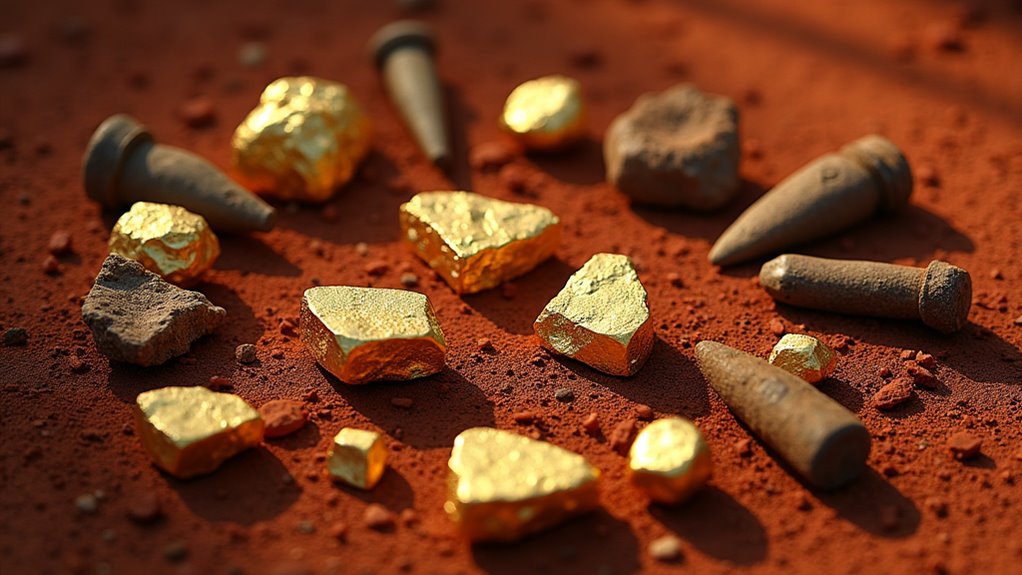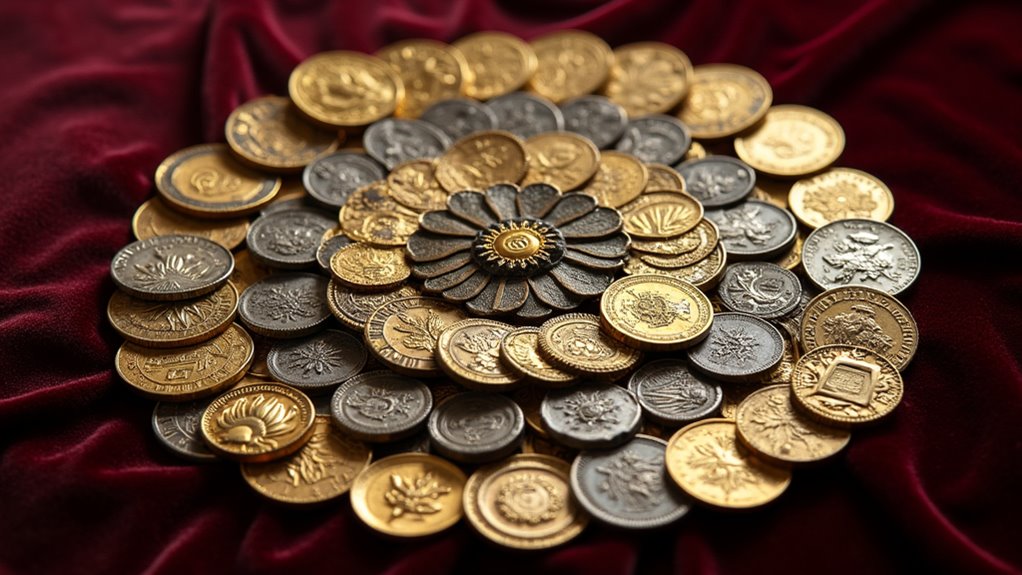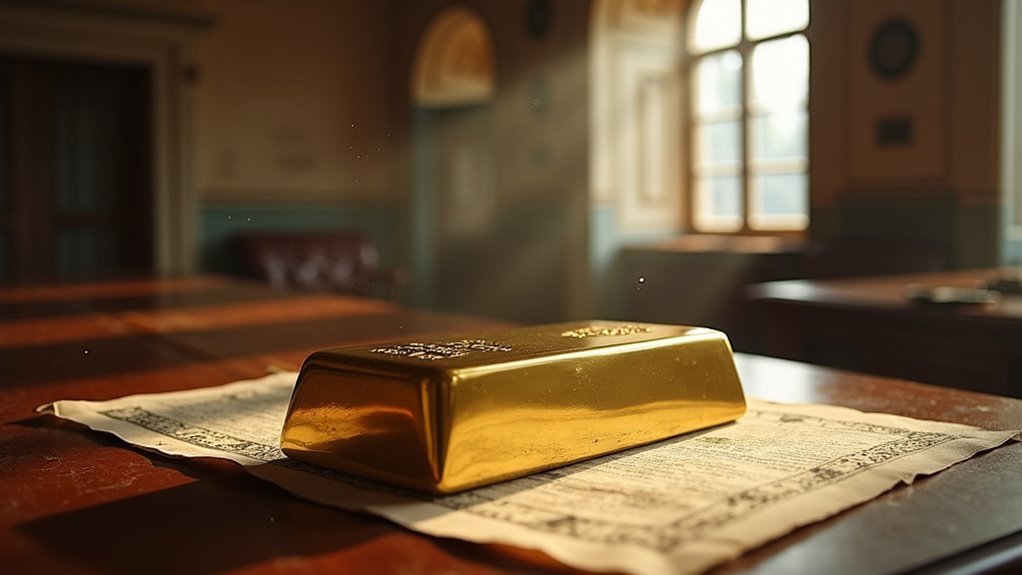Museums preserve gold artifacts through rigorous conservation protocols. Temperature and humidity controls are maintained at 20-22°C and 40-50% respectively, while staff handle pieces with protective gloves to prevent contamination from skin oils. Structural support systems, acid-free storage materials, and custom display cases protect against physical damage. Authentication processes include spectroscopic analysis and detailed documentation. Regular monitoring and ethical sourcing practices guarantee these precious treasures endure for future generations. Discover the fascinating world of museum conservation techniques.

The preservation of gold artefacts in museums represents one of the most meticulous endeavours in cultural heritage conservation. Despite gold’s inherent resilience as a noble metal, these precious historical pieces require careful attention to guarantee their longevity for future generations. Museums employ sophisticated climate control systems to maintain ideal conditions, with temperatures hovering around 20-22°C and relative humidity carefully regulated between 40-50% to protect not just the gold, but also any composite materials present in these artefacts. Additionally, the use of ethical sourcing practices ensures that the gold used in modern reproductions or repairs does not contribute to environmental harm or social injustice. Furthermore, understanding gold hallmarking can provide insights into the quality and authenticity of the materials used in these artefacts. Moreover, the practice of gold recycling serves to reduce the demand for newly mined gold, thereby supporting sustainability in the conservation of cultural heritage. In addition, promoting ethical sourcing in gold supply chains becomes crucial for preserving both artifacts and the environment.
The handling of these treasured pieces demands strict adherence to established protocols. Museum staff invariably don gloves when touching gold artefacts, preventing contamination from skin oils and acids that could potentially damage these delicate items. Cleaning procedures are equally precise, utilising soft brushes and lint-free cloths to remove dust and debris without risking abrasion to the surface. Chemical cleaning agents are approached with extreme caution, and any new cleaning solution must first be tested on an inconspicuous area.
Museum professionals handle gold artifacts with meticulous care, using protective gloves and gentle cleaning techniques to preserve these irreplaceable treasures.
Structural support plays a significant role in preserving gold artefacts, particularly those with intricate designs or thin components susceptible to deformation. Museums implement reversible mounting systems that provide necessary reinforcement while remaining visually discrete. These supports are especially important during transportation, when custom-padded cases are employed to shield artefacts from harmful vibrations and physical stress.
Authentication and documentation form the cornerstone of museum conservation practises. Institutions regularly conduct spectroscopic analysis to determine precise chemical compositions and verify authenticity. High-resolution photography and 3D imaging create detailed records that prove invaluable should restoration ever become necessary. Regular collaboration with archaeologists and historians ensures the accuracy of historical attribution and helps maintain the integrity of museum collections.
Storage solutions are carefully designed to protect gold artefacts during periods when they’re not on display. Acid-free tissue paper and archival-quality boxes prevent tarnishing and physical damage, while silica gel packs help regulate moisture levels. Custom-built storage compartments keep pieces separated, preventing contact damage that could occur between items.
Display cases incorporate advanced monitoring systems, including humidity and pollution sensors, enabling real-time tracking of environmental conditions. Additionally, museums increasingly consider the impact of sustainable practices in their conservation strategies to ensure that both the artefacts and the environment are preserved for the future.
The conservation of gold artefacts requires a delicate balance between preservation and accessibility. While these precious items must be protected from environmental factors and physical damage, they also need to remain available for study and public appreciation. Through careful attention to climate control, handling protocols, structural support, authentication procedures, and storage practises, museums successfully maintain these irreplaceable pieces of cultural heritage for future generations to study and admire.
Frequently Asked Questions
How Much Does It Cost Museums to Maintain Gold Artifacts Annually?
Museums typically spend between $120,000 to $600,000 annually to maintain gold artifacts, depending on their collection size and resources.
Major expenses include specialised conservation staff ($50,000-$100,000), environmental controls ($17,000-$80,000), essential equipment and materials ($28,000-$165,000), and insurance ($10,000-$200,000).
Smaller institutions might spend around $120,000 yearly, while larger museums with extensive collections face costs exceeding half a million dollars.
Can Visitors Touch Gold Artifacts Under Special Supervised Conditions?
Visitor access to gold artifacts in museums is highly restricted, though some institutions offer supervised handling experiences under strict conditions.
These interactions typically occur during educational workshops or special exhibitions, where visitors must wear protective gloves and follow rigorous protocols.
Most museums, however, prefer to use high-quality replicas instead of authentic pieces to protect their invaluable collections whilst still providing an engaging, hands-on learning experience.
What Happens to Damaged Gold Artifacts That Cannot Be Restored?
Damaged gold artifacts that cannot be restored still serve valuable purposes in museology. They become important research specimens for studying ancient metallurgy and historical craftsmanship.
Many museums catalogue these pieces and store them in specialised facilities with controlled environments. While some artefacts may be displayed in their damaged state to showcase historical context, others are digitally reconstructed to demonstrate their original appearance without compromising the actual piece’s integrity.
How Do Museums Determine Which Gold Pieces Deserve Priority Conservation?
Museums prioritise gold artifacts based on several key factors.
Pieces facing immediate deterioration or structural instability receive urgent attention. Items with significant cultural or historical value, particularly those representing unique craftsmanship or religious importance, are given precedence.
Upcoming exhibitions and research requirements also influence conservation schedules. Additionally, available resources, specialised expertise, and the institution’s specific priorities help determine which pieces receive conservation treatment first.
Do Museums Ever Sell Damaged Gold Artifacts to Private Collectors?
Museums generally do not sell damaged gold artifacts to private collectors. This practice is heavily restricted by international conventions like UNESCO 1970 and national heritage protection laws.
Most reputable institutions prioritise preservation and restoration, regardless of an artifact’s condition. The sale of such items could encourage illegal trafficking and potentially result in irreplaceable historical pieces being melted down.
Museums typically opt to store or display damaged artifacts as educational exhibits.












